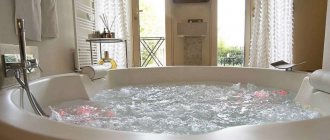Classic style is aristocratic restraint and elegance. It is generally accepted that only rooms with solid functionality, for example, a living room or dining room, should be decorated in this design. Have you ever seen what a classic style bathroom looks like? No? Then it’s time for you to get acquainted with such an interior, especially if you are a person with a considerable level of income and are ready to personify your status.
classic style bathroom
The classic style is incredibly popular, and finding it today in its pure form is quite difficult. It was imbued with the characteristic features of the regions where it is used, and received a lot of varieties. Despite this, the basic ideas of classicism remained unshaken.
Anyone can reproduce a classic bathroom interior. It won't require millions. Just follow a number of canons and you will certainly get the desired result. What characterizes style?
- Strict lines.
- Presence of antique finishes.
- Sustained colors.
a small bathroom tiled with monotonous tiles in light colors
You can, of course, make a palace version with gilding, stucco, false columns, but this, as they say, is a matter of wealth. The main attribute of classical decor remains the antique ornament, famous for its repeating elements. The most common motif is vine weaving. Where can you see this beauty? On a frieze of ceramic tiles, which will separate sections of the walls, zoning the space, simply go under the ceiling, like regular decor, or delimit the wall in a horizontal plane, separating the panel part from the top. Decorative polyurethane and plastic friezes bearing such an ornament are used to separate the ceiling from the walls. Grape weaving can appear on furniture facades and in the design of mirrors.
restraint of colors, strict lines of decorative items and furniture
The interior of a classic-style bathroom can be interpreted very widely. After all, each nation brought its own national concepts to the direction. Some people see the classics in antiquity, others are closer to the Roman clarity of lines. There are adherents of the English interpretation, where colors explode in an aristocratic interior. There is also a Russian version, pompous and rich. But if you try to take a closer look, you will see that the presented options have something in common. This is the severity of lines, symmetry, correct proportions and luxury in decor.
A little history
But first, let’s pay attention to the history of the emergence of this trend in the interior in order to better understand it. And this will help in its correct implementation.
It must be said that the ancient Greeks did not particularly care about the interior design of the premises. Thanks to the warm climate, they were most often outdoors, so the decoration in the houses had rough features, and the shapes of the furniture were characterized by primitivism. It was later, with the development of civilization, that the Greeks began to gravitate towards luxury.
Coffered ceilings were invented by the ancient Greeks. They came up with the idea of replacing the column using a female statue. By the way, this decision appeared after well-known events, when in the city of Karia the female half of society found themselves in heavy slavery.
The Greek zigzag pattern is a symbol of the Meander River, which has similar bends.
Tile with dramatic patterns
Another bathroom in which the desired retro effect was achieved through black and white tiles. This time it's not about geometry, but about patterns. The patterns on the rug, walls, floor and even the textile chair cover look excessive, although they work well together, and the green accents soften the effect.
Photo:
Style Features
Let us immediately note that very often the Greek direction is confused with the Roman one. Of course, this is incorrect, since the styles are very different. For Roman, luxury is more relevant, while for Greek, confident simplicity is more relevant. The Greek-style bathroom features frescoes, fairly high ceilings and characteristic stucco. And it is important that the color scheme has a natural basis.
Pastel colors are used in this direction: delicate lemon and olive, blue shades. The Greek style rejects bright colors and gilding. Let elegance remain, but it should not turn into pompous luxury. Restraint is encouraged.
Ceramic tiles, wood, stone, marble and even granite can be used as finishing materials. Of course, Greek-style bathroom tiles are the simplest solution, since this material is traditional for decorating this room.
Expressive elements of the Greek style are columns. They add a sense of grandeur to the interior.
Despite a certain asceticism in decoration, expressive decorative items are used. These can be large vases, mirror paintings, figurines.
Color solutions for a classic bathroom
“Our compatriots prefer to see a classic-style bathroom in a brown and beige design, although snow-white marble in the spirit of the decor of Roman baths framed in black would also look good.”
The classic style is quite calm, so flashy colors and violent contrasts should not appear in the bathroom decor. The basis of the classic palette are pastel colors:
- Beige.
- Cappuccino.
- Cream.
- Grey.
- Sand.
the predominant white color of the bathroom mutes the contrast of the dark floor
Chocolate, burgundy and bottle colors are also welcome here. As an accent, you can introduce a little red or add light green shades.
Our compatriots prefer to see a classic-style bathroom in a brown and beige design, although snow-white marble in the spirit of the decor of Roman baths framed in black would also look good. You can add green, pink, blue colors; they will be quite appropriate in a classic setting. There is no place here for artificially synthesized shades.
Duets of beige and chocolate, gray and burgundy, white and brown, milky and olive, framed by golden decor, are good in such interiors.
trio: a combination of black with white and blue shades
Wall decoration
Greek style bathroom design requires the use of certain materials. Wallpaper is not an option you should think about. More attention needs to be paid to more “ancient” materials, for example, plaster. It can be painted in light colors.
You can decorate surfaces with ornaments, using, for example, the same Greek zigzag pattern. You can also make a painting on a mythological theme. It can be a unique addition to your interior design.
Choosing plumbing fixtures and furniture for a Greek interior ↑
As for plumbing, for the Greek style, the best option would be products with light gilding. A classic-shaped bathtub with curly legs will fit perfectly into the overall atmosphere.
The main rule in choosing a bathroom: smooth lines and features, discreet colors, no strict or sharp corners!
A bathtub with smooth, streamlined shapes and curly legs is an ideal option for a Greek interior
Another good solution is to install a modern jacuzzi with bronze-colored faucets. The floor around the jacuzzi can be covered with decorative pebbles. To emphasize the Greek style, decorate the shower with tiles depicting the gods of Ancient Greece. The color of heated towel rails should match the color of the faucets (preference is usually given to bronze and gold). Unusual forms of plumbing equipment are welcome. The plumbing itself, be it a toilet, bathtub or sink, should be predominantly white. The main features of the products present in the Greek interior are massiveness and unique artistic execution. A large mirror with an ornament will be an excellent addition to the design.
Details will help emphasize the style
Since such rooms usually have a large space, they should be complemented by a set of beautiful furniture. It can be:
- wooden cabinets;
- dressing table;
- benches;
- small soft sofa;
- low wooden chairs;
- couches.
Worth paying attention! Any furniture should be squat, simple, and have slightly rough features. Recommended upholstery for upholstered furniture is pastel or plain fabric. Preferred decorations are forged parts and carvings.
The design of this bathroom is thought out to the smallest detail.
Even such a non-standard combination of colors, with the right approach, creates references to the legendary Greece.
Ceiling decoration
One of the features of the Greek style is that the entire composition “points” to the ceiling. Therefore, it should emphasize the chosen direction, focusing attention on the chandelier framed by massive stucco molding.
You can use caisson, tension or suspended solutions. And here it is important to restrain yourself in colors and details. Then the effect will be decent.
You can decorate the bathroom ceiling in the Greek style using the fresco technique. If there is a tension structure, the use of photo printing is allowed. And you can add lighting around the perimeter, which will highlight the relief of the plinth on the ceiling.
Bathroom in a classic style: materials for decoration
In the traditional design, the classic decor is made of marble, wood, and stone.
The decorative elements on the walls and ceiling include stucco. Agree, the average person cannot afford such luxury. Let's see what designers recommend that we replace these luxurious natural materials with. Let's start with marble. It can be imitated by ceramic tiles on walls and floors. Today it can be found in a variety of interpretations, including marbled ones. On floors, tiles can be replaced by self-leveling technologies. This coating will have the pattern you want, even repeating the pattern of the wood cut. An alternative to wooden doors will be products made from MDF. In order for them to look expensive, they need to be treated with decorative materials, then in appearance they will differ little from real oak doors. If you want to decorate a bathroom in a classic style and the rest of the finishing (a cabinet for bath accessories, a screen for sewing up a bathroom, etc.) should be done with a cheaper material than wood, then it is better to use high-quality plastic.
using ceramic mosaics in a classic style bathtub interior
Regarding the ceiling finishing. I would especially like to highlight the tension structures. Although this is a more than modern solution, however, it will not be contrary to the classical style if you do not forget to highlight its junction with the walls with a decorative frieze. The frieze must certainly have an ornament. It is rational to replace the gypsum stucco molding on the bathroom ceiling with polyurethane analogues of the elements or use moldings. The latter should also be:
- made of plastic;
- polyurethane;
- polystyrene.
Not every bathtub has enough space to install columns in it, but they are indispensable companions of classicism. This dilemma also has a solution. It is permissible to replace them with pilasters.
the presence of wooden coverings of furniture and decor in the interior of a classic bathroom
Let's return to the decor of bathroom walls in a classic style. More precisely, to the question, what other materials can they be decorated with? In addition to the considered standard option in the form of ceramic tiles, wall surfaces can be finished with Venetian plaster. If it is properly processed and polished, it will be practically indistinguishable from marble. The positive qualities of this finish include not only its visual similarity with expensive material, but also its no less practicality in conditions of high humidity. It will be easy to care for such walls because they can be washed.
Furniture
Furniture should be in abundance, but not in excess. There should be enough air in the interior. The ancient Greeks did not put forward any special requirements for furniture; they were unpretentious in relation to these items. But they have some characteristic features. For example, tables and chairs have legs that are bent to the outside. The upholstery of the sofas is simple but good quality. Tables may have bronze legs.
Let us recall that in antiquity food was taken lying down, so only conditional requirements were put forward for furniture.
What to choose?
Collections in antique style are produced by many well-known European manufacturers. Among the Italian factories it is worth noting:
- Tagina: collections Berenice , Pompeiana , Dore , Minoica and others;
- Vallelunga: collections Hermitage , Pietra Lavica , Pietra di italia , Via Veneto , Villa Ada , Villa D'Este ;
- Elios: Wine Country , Mithos ;
- Imola Ceramica: Pompei ;
- ABK: Romanica and Appia .
In the photo: ABK Appia ceramic tiles.
Among Spanish-made tiles there are also many interesting collections in antique style:
- Peronda: collections Imperador , Il Divino ;
- Halcon: Fatima-orsay and Victoria ;
- Aparici: Tirreno , Ego , Statuario .
In the photo: tiles from the Tagina Rondo series.
Recommendations from professionals
And finally, here are some tips that the masters give.
- A niche is a current attribute of the antique style. In modern conditions, a niche can be made from metal profiles and drywall. However, this solution is more suitable for spacious bathrooms, since it “eats up” space. By supplementing such a niche with gentle lighting and a figurine, you can get an attractive effect.
- If the volume of the room allows, it is better to install four or more columns. Otherwise, pilasters will do.
- Instead of a mural, you can use high-quality photo wallpaper. They can be made to order. The joints can be decorated with a baguette and painted bronze.
In a word, thanks to the presence of a large assortment of building materials, it will not be difficult even for a beginner to implement the Greek style in the bathroom. In addition, you can see photos of how this design is implemented by professionals. Based on this data, it will be easier to come up with your own option. And then try to implement it efficiently.
Lighting for a classic bathroom
The lighting fixtures that can be seen in a classic-style bathroom have a very unusual structure .
This is a peculiar mix of modern filling and retro exterior. The historical roots of the classics are incredibly deep, however, these interiors require good lighting. In the conditions of the current forced economy, energy-saving lamps will help solve this problem. They shine well and consume minimal amounts of electricity. When choosing lamps, make sure that their technical characteristics include permission to use fluorescent and LED lamps. As for the exterior, everything here should correspond to the style of the bathroom design. Wall lamps can be imitation candles. Wall sconces and candelabra will do. In such an interior, even a crystal chandelier may appear under the ceiling, and it will also not be superfluous. Spot ceiling lamps are good, the main thing is to fit them organically into the decor.
bathroom accent, crystal chandelier with LED lamps imitating candles
Plumbing comes to the fore again
A prime example of how to create a retro-style interior using an antique claw-foot sink and taps with a vintage silhouette. Notice the color of the wall - again pale turquoise.
Photo:










